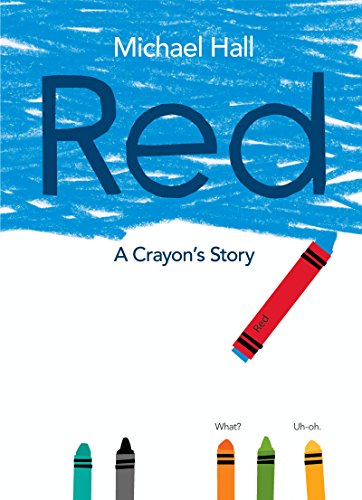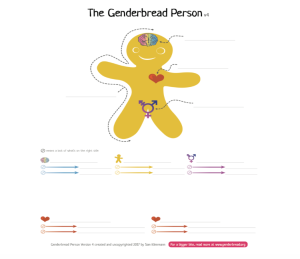Gender Identity & Gender Roles

Author(s): Michael Hall
Links:
Amazon: https://amzn.to/2XpHEgU
Indigo: https://bit.ly/3dFuAK9
Social Justice focus: Identity Crisis
Synopsis: This book is based on the theme of identity crisis, whereby Michael Hall emphasizes on the importance of being true to your inner self and follow your own unique path despite the obstacles that one faces along the way. Red and blue are two different colours, offering two different perspectives and both are beautiful in their own ways.
Lesson Plan: Victoria Nestico
Primary/Junior/Intermediate Lesson Plan (Abbreviated Template)
Consecutive and Concurrent Programs
Unit/Topic: Gender Identity, Gender Expression and Sexual Orientation
Grade: 7
Lesson: What is the focus of this lesson in relation to the unit? This lesson will focus on the LGBTQ+ community and allowing students to understand and distinguish between gender identity, gender expression and sexual orientation using the book Red as a source of inquiry.
Curriculum Areas: Language Arts, Health & Phys-Ed, Drama
Curriculum Expectations: What Overall and Specific Expectations will be addressed?
Overall Expectations:
Language Arts: Reading
- read and demonstrate an understanding of a variety of literary, graphic, and informational texts, using a range of strategies to construct meaning
- recognize a variety of text forms, text features, and stylistic elements and demonstrate understanding of how they help communicate meaning;
Drama
B1.Creating and Presenting: apply the creative process (see pages 19–22) to process drama and the development of drama works, using the elements and conventions of drama to communicate feelings, ideas, and multiple perspectives
B2. Reflecting, Responding, and Analysing: apply the critical analysis process (see pages 23–28) to communicate feelings, ideas, and understandings in response to a variety of drama works and experiences;
Health and Physical Education: Healthy Living
D2. demonstrate the ability to apply health knowledge and social-emotional learning skills to make reasoned decisions and take appropriate actions relating to their personal health and well-being;
Specific Expectations:
Language Arts: Reading
1.1 read a wide variety of increasingly complex or difficult texts from diverse cultures, including literary texts
1.3 identify a variety of reading comprehension strategies and use them appropriately before, during, and after reading to understand increasingly complex texts
1.5 develop and explain interpretations of increasingly complex or difficult texts using stated and implied ideas from the texts to support their interpretations
1.6 extend understanding of texts, including increasingly complex or difficult texts, by connecting the ideas in them to their own knowledge, experience, and insights, to other familiar texts, and to the world around them
2.4 identify various elements of style – including foreshadowing, metaphor, and symbolism – and explain how they help communicate meaning and enhance the effectiveness of texts
Drama
B1.1 engage actively in drama exploration and role play, with a focus on examining multiple perspectives related to current issues, themes, and relationships from a wide variety of sources and diverse communities
B1.2 demonstrate an understanding of the elements of drama by selecting and combining several elements and conventions to create dramatic effects
B1.3 plan and shape the direction of the drama by working with others, both in and out of role, to generate ideas and explore multiple perspectives
B2.1 construct personal interpretations of drama works, connecting drama issues and themes to their own and others’ ideas, feelings, and experiences
Health and Physical Education
D2.4 demonstrate an understanding of physical, emotional, social, and cognitive factors that need to be considered when making decisions related to sexual health
Learning Goal(s): What are students expected to know, do and understand?
We are learning to….
Read and understand a variety of texts
Develop and explain interpretations of texts using stated and implied ideas
Connect ideas from a text to the world around us, and our prior knowledge
Identify metaphors and symbolism in the mentor text
Engage in drama role play with a focus on perspectives related to the text
Demonstrate an understanding of the elements of role on and the wall and tableaux
Construct meaning from our interpretation of a drama work
Demonstrate an understanding of the physical, emotional, social and cognitive factors about our sexual health
Success Criteria: How will students know they have met the learning goal?
I can….
Read the picture book Red by Michael Hall and make connections between myself and the world around me
Explain interpretations of the book to my classmates
Identify metaphors and symbolism in the mentor text
Participate in the Role on the Wall activity with my group members
Create a variety of tableaus to represent my interpretation of implied information from the text
Distinguish between sexual orientation, gender identity, gender expression
MODIFICATIONS/ACCOMMODATIONS: How will I meet the needs of my students? Have I addressed any IEPs?
Modifications:
Can be made according to students and their IEP recommendations. Modifications can be made to the reading expectations, health expectations or drama expectations depending on the student.
Accommodations:
- Audiobook of Red by Michael Hall available on YouTube here for students who may need it https://www.youtube.com/watch?v=ytZ2fhuj6kA
- Strategic grouping for the collaborative aspects of the tasks
- Genderbread answer key provided for the worksheet for students.
- Extended time for students to complete their tableaux and worksheet
Minds-on: How will I connect to prior and future learning? How will I engage students and set the context for learning?
Minutes: 15 mins.
Task: What will I be doing? What will students be doing?
Give each student a mislabelled crayon and get them to draw something that is not the colour of the crayon. For example: give someone a green crayon mislabelled as yellow crayon and get the student to draw a sun. Tell the students that they cannot switch crayons with anyone else and they must draw what they were told to draw. Ask the students how they felt when they couldn’t properly draw what they were told to do? How could they solve the issue? Did they feel as though someone was asking them to do something that they were not able to do?
After they discuss, get the students to draw something with the crayon that they feel represents their colour more. What did you choose to draw? Why? How did it make you feel when you could draw what represented your colour more?
Read the book Red by Michael Hall to the class.
Ask the students: What is this book talking about? What perspective is the story being told from? Is there a narrator for the story?
What is gender identity? – Get the students to use sticky notes to write a short definition of what they know as gender identity and place it on the board.
What is sexual orientation? What is gender expression?
Discuss with students what these terms mean.
Play the YouTube video: https://www.youtube.com/watch?v=Vlx9iZ9g_9I
Assessment: For learning- Anecdotal Records of the conversations occurring with students. Do they understand the premise of the book? Do they understand the difference between sexual orientation, gender expression and sexual orientation? Can the students make connections between the text and the definition of gender identity?
Action: How will I introduce new learning / reinforce prior learning / practice learning / scaffold learning?
Minutes: 30 mins.
Task: What will I be doing? What will students be doing?
After the students have had a discussion about gender identity, gender expression and sexual orientation, organize the students into groups of 3-4. Provide each group of students with a chart paper and markers. They will be required to draw the outline of a person. Each group will be assigned a different character from the book (Group 1: Red crayon, Group 2: purple crayon, Group 3: Red crayon). Get the students to conduct the Role on the Wall activity. The students will put words inside the outline of the body that represent how the character feels and what the character feels people think about them. The students will write words outside of the outline of the body that represent how other people perceived them/what they thought about them.
Get the students to work on this portion of the lesson for 20 mins. Go around the room and ask/pose questions about how the emotions of what they were feeling and what people were saying about them relate to gender identity. How do they relate to the story?
Get the students to present their posters and quickly explain why they chose the words inside/outside of the outline. Is there any textual evidence to support your word? Did you have to imply information to make these connections about emotions?
Students will make a series of tableaus to represent their role on the wall activity, students will present these to the class. The teacher will prompt the students with: what emotion did you feel when you watched the tableaux?
Assessment: For learning- anecdotal records of the conversations that students are having with each other. Circulate through the classroom and ask the different groups how the words they chose can relate to gender identity? Did you experience similar feelings to the characters when we did the task at the beginning of the lesson?
Consolidation: How will I reflect on the learning goal? How will I have students reflect on the learning goal?
Minutes: 10 mins.
Task: What will I be doing? What will students be doing?
After discussing gender identity, sexual orientation, gender expression, hand the students the Genderbread worksheet [Appendix A].
In pairs, the students should distinguish between the various parts of the Genderbread and determine which parts represent the definitions mentioned in the Minds On. The Genderbread worksheet will be used as an assessment tool to ensure that students can distinguish between gender identity, gender expression and sexual orientation.
Assessment: For learning – exit ticket.
MATERIALS: What resources and materials do I need? Where can I find them? In a perfect world what other resources might I need?
- Red by Michael Hall
- Chart Paper
- Markers
- Genderbread worksheet
REFLECTION: Questions to determine the success of your lesson:
- Were my students successful in meeting the learning goals and success criteria? How do I know?
- Did my instructional decisions meet the needs of all students? If not, what are my next steps?
- What worked well and why?
- What will I do differently in the future when teaching this lesson? For the subsequent lesson?
- What are the next steps for my professional learning?


